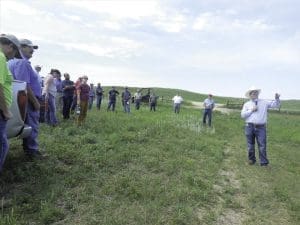By Patti Wilson Contributing Editor

When you think of the word laboratory, what do you envision? Probably a climate-controlled room with counters full of test tubes and ventilation hoods, and scurrying, white-coated technicians. Perhaps a few bubbling beakers suspended over Bunsen burners.
Throw out that thought and enter the University of Nebraska-Lincoln (UNL) Barta Brothers Ranch near Bassett, Neb. It is a 6,000-acre property that was donated to the university by Clifford and James Barta in 1996. Used to study livestock grazing systems, plants and water in grasslands, it is also important to students and those pursuing continuing education.
Staff at the Barta Ranch hosted an open house on July 25, focusing on the control of woody encroachment (the spread of Eastern red cedar), which academia has dubbed “The Green Glacier.” Forestation is moving north toward Canada and has become a growing problem in mid-America grasslands in recent decades.
Mechanical control such as cutting the trees is effective. Prescribed burns, however, are highly recommended by Barta staff, having been researched for years at the sprawling facility. It is found to be a more effective and efficient means of eliminating the persistent pests.
After classroom presentations in the morning, a pasture tour was on the afternoon agenda as two trailer loads of eager guests loaded up for an open-air ride to paddocks of light sand that had been burned the previous spring. Although cedars are kept under control by burns, the jury is still out on the effect these burns have on leafy spurge, another growing grassland problem. Currently, herbicide is employed in the control of spurge on the ranch.
Other studies being conducted on the Sandhills spread include avian research on a dozen bird species, particularly prairie chickens. Mob grazing and rotational grazing systems on upland pastures and lowland meadows are also monitored.
One of the most interesting take-home thoughts from the conference included the use of a smart phone app that measures biomass (plant growth) in a given area. Another is the explanation of the “Green Glacier” effect. In the early 1900s, trees were used to build facilities on farms and ranches. Not so anymore. Tree-killing prairie fires are now less severe due to large areas that are farmed and no longer grazed. Fire departments are more abundant, and windbreaks continue to provide a never-ending supply of seed. Circumstances have added up.
The Barta Ranch is in the Collaborative Adaptive Management Program, which entails a dozen entities with ties to conservation. Examples are the Nebraska Game and Parks Commission, Nebraska Forest Service, Natural Resources Conservation Service, U.S. Fish and Wildlife Service and the Nature Conservancy, among others. Currently, there have been 26 master’s degree students in training at the ranch, four doctoral students and 30 undergraduates busy with research.
There’s a whole lot of work going on in a very secluded place. It’s a benefit to all cattlemen.





